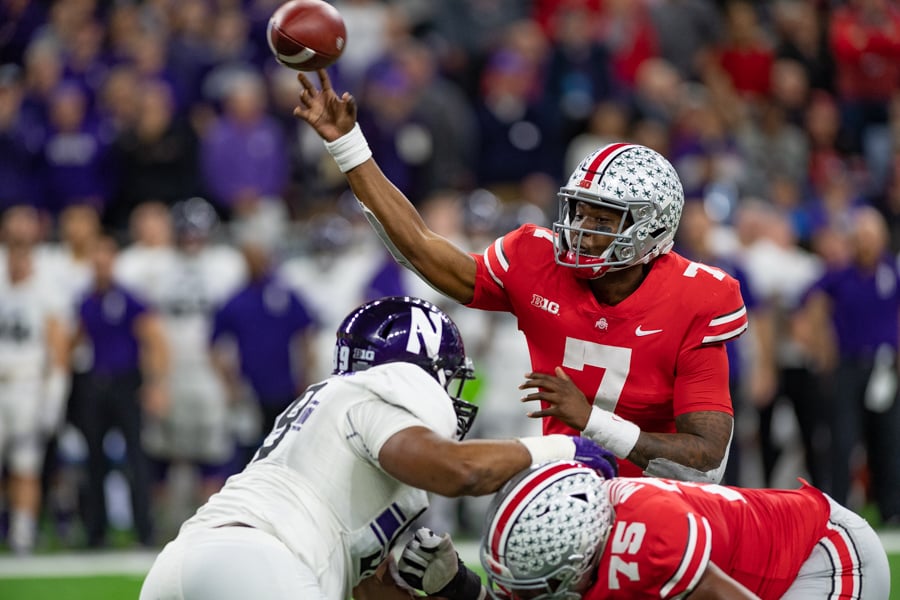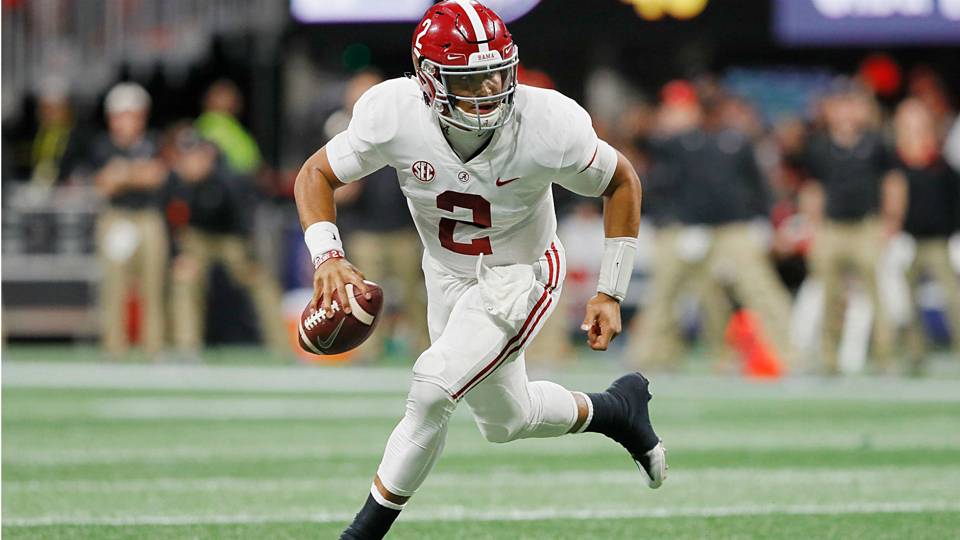I never got into college football growing up, partially because my dad wasn't into it, but there was also the corrupt system of the BCS that played a role. While this book is somewhat out of date, I highly recommend reading it if you haven't; it's extremely enlightening about the extreme flaws with the old system, most exemplified in the LSU-Alabama title game that completely invalidated the 2011 regular season.
Wetzel, Peter, and Passan also built out an alternative playoff format that I love and have used every year since. It's had to be revised since the death of the WAC, but the revision was minor. The authors call for a 16 team playoff that includes every conference champion, plus at large teams to fill out the field. They recommend a selection committee to build the field, but in the absence of one, I've elected to fill the field every year myself.
:format(webp)/cdn.vox-cdn.com/uploads/chorus_image/image/62609011/1067373794.jpg.0.jpg) |
| Photo by Grant Halverson (Getty Images) |
To ensure that I leave out room for bias, I also take into account three different sets of computer rankings, grabbing the average of the three to get a rough picture. These three rankings all take margin of victory into account: Jeff Sagarin's, the late David Rothman's, and those from the website All My Sports Teams Suck. I will also look at record against other playoff teams starting just with the conference champions and adding in the at large teams as I pick them. This factor will help mostly with seeding, but may also help when I look at picking the at large teams.
So without further ado, here is your field for the 2018 Death to the BCS Playoffs!
- Alabama (13-0, SEC Champion)- PP1: 69, PP2: 25.75, aPP: 69; SAG: 1, ROTH: 1, AMSTS: 1 (7th appearance, 7th consecutive)
- Clemson (13-0, ACC Champion)- PP1: 76, PP2: 28.50, aPP: 76; SAG: 2, ROTH: 2, AMSTS: 2 (4th appearance, 4th consecutive)
- Notre Dame (12-0, At Large)- PP1: 77, PP2: 31.00, aPP: 77; SAG: 7, ROTH: 4, AMSTS: 3 (4th appearance, 2nd consecutive)
- Georgia (11-2, At Large)- PP1: 70, PP2: 29.64, aPP: 67; SAG: 3, ROTH: 3, AMSTS: 4 (3rd appearance, 2nd consecutive)
- Oklahoma (12-1, Big 12 Champion)- PP1: 64, PP2: 26.27, aPP: 61; SAG: 6, ROTH: 14, AMSTS: 8 (6th appearance, 4th consecutive)
- Michigan (10-2, At Large)- PP1: 58, PP2: 26.90, aPP: 57; SAG: 5, ROTH: 12, AMSTS: 7 (2nd appearance, 1st since 2016)
- LSU (9-3, At Large)- PP1: 49, PP2: 25.22, aPP: 42; SAG: 14, ROTH: 5, AMSTS: 9 (1st appearance)
- UCF (12-0 American Athletic Champion)- PP1: 57, PP2: 20.64, aPP: 57; SAG: 18, ROTH: 10, AMSTS: 5 (3rd appearance, 2nd consecutive)
- Washington (10-3, Pac 12 Champion)- PP1: 50, PP2: 26.33, aPP: 36; SAG: 9, ROTH: 19, AMSTS: 19 (2nd appearance, 1st since 2016)
- Washington State (10-2, At Large)- PP1: 51, PP2: 21.00, aPP: 41; SAG: 16, ROTH: 20, AMSTS: 17 (1st appearance)
- Boise State (10-3, At Large)- PP1: 60, PP2: 21.80, aPP: 49; SAG: 29, ROTH: 36, AMSTS: 23 (4th appearance, 2nd consecutive)
- Fresno State (11-2, Mountain West Champion)- PP1: 46, PP2: 16.70, aPP: 38; SAG: 23, ROTH: 28, AMSTS: 16 (2nd appearance, 1st since 2013)
- Northwestern (8-5, Big Ten "Champion")- PP1: 43, PP2: 26.25, aPP: 39; SAG: 37, ROTH: 31, AMSTS: 33 (1st appearance)
- Appalachian State (10-2, Sun Belt Champion)- PP1: 42, PP2: 16.56, aPP: 36; SAG: 44, ROTH: 37, AMSTS: 20 (1st appearance)
- UAB (10-3, Conference USA Champion)- PP1: 39, PP2: 14.22, aPP: 24; SAG: 77, ROTH: 71, AMSTS: 43 (1st appearance)
- Northern Illinois (8-5, MAC Champion)- PP1: 37, PP2: 18.57, aPP: 12; SAG: 75, ROTH: 74, AMSTS: 58 (3rd appearance, 1st since 2014)
To view the official bracket, click here.
 |
| Photo by Noah Frick-Alofs (The Daily Northwestern) |
There are two processes I need to go over: first how I decided the teams, and second how I seeded them. Starting with picking the 16, I went with the automatic bid game winners from last week's post. This meant UCF, Clemson, Oklahoma, UAB, Northern Illinois, Fresno State, Washington, Alabama, and Appalachian State all received automatic bids. Northwestern received the Big Ten automatic bid by virtue of Ohio State's suspension despite losing to the Buckeyes on Saturday. Those ten teams are all in, with the six at larges still up for debate.
For the at large bids, I copied the process the NCAA Division III selection committee uses to determine at large participants in its championship tournaments with a modification: each conference gets a seat "at the table" with the independents counting as a conference for the purposes of this discussion. Standings will play a large role in the decision, meaning in most cases the loser from the conference title game will be the first to the table, but this is not a guarantee; better metrics may override head-to-head victories or places in the standings. This is to ensure I try not to "block" a deserving team.
Thus, our first round of debate looks like this, with the team I chose in bold:
- Cincinnati, Syracuse, Michigan, Texas, Middle Tennessee, Notre Dame, Buffalo, Boise State, Washington State, Georgia, Troy
This was the easiest decision on the board. Notre Dame is undefeated, had the highest PP1, PP2, and aPP in the country, and the second-best computer ranking average of all at large teams. Add in a win over playoff-bound Northwestern and this just makes it more of a lock.
- Cincinnati, Syracuse, Michigan, Texas, Middle Tennessee, BYU, Buffalo, Boise State, Washington State, Georgia, Troy
Another pretty easy decision here. Georgia was one of only three teams in the FBS to top 70 PP1 for the season and have the highest of all three Playoff Point metrics of all teams at the table. The fact that they were the highest computer-ranked team at the table coming in meant that their wait wasn't going to be long.
- Cincinnati, Syracuse, Michigan, Texas, Middle Tennessee, BYU, Buffalo, Boise State, Washington State, LSU, Troy
Ohio State may have won The Game (and officially the Big Ten title), but it's Michigan who gets the honor of playing postseason football with the best metrics of every team remaining on the board as our first at large team of the year below 60 PP1, with their two losses coming to a playoff team and a team that would have been were they eligible.
- Cincinnati, Syracuse, Iowa, Texas, Middle Tennessee, BYU, Buffalo, Boise State, Washington State, LSU, Troy
- Cincinnati, Syracuse, Iowa, Texas, Middle Tennessee, BYU, Buffalo, Boise State, Washington State, Texas A&M, Troy
Pat Chun can relax a little bit as the Pac 12 gets a second team into the tournament. It's getting tougher as we get closer to the end of the bracket, but the fact that they only lost two games all season has to count for something. Their Playoff Points match up pretty favorably with the remaining teams at the table, and they're top 20 in every computer ranking. Only having one result against a playoff opponent doesn't really help a ton, but it doesn't hurt either.
- Cincinnati, Syracuse, Iowa, Texas, Middle Tennessee, BYU, Buffalo, Boise State, Utah, Texas A&M, Troy
I thought long and hard about this one, ultimately debating between Boise State and Texas, and it was really close. Boise State had the extra win, albeit against a weaker schedule on the whole, but played a balanced schedule of six games at home and on the road in the regular season. Texas, meanwhile, played six home games but only four true road games, with a couple neutral site contests not counting the conference title game... and that's factoring in that the Red River Rivalry is played in Texas. Boise State had a higher PP1, though their PP2 was dragged down in particular by Connecticut. Texas did have the higher computer rankings as well as the better win (Oklahoma, compared to Fresno State), but the Maryland loss sticks to me for the Longhorns as well as the fact that they are a four loss team.
 |
| Photo from Getty Images (Photographer uncredited) |
:format(webp)/cdn.vox-cdn.com/uploads/chorus_image/image/62607988/usa_today_11765901.0.jpg) |
| Photo by Tim Heitman (USA TODAY Sports) |
That puts Oklahoma squarely in the #5 seed as the best team left on the board. Michigan comes in right behind them as the #6 seed as once again the best team on the board, something I can't change even if it's to avoid a potential second round rematch against Notre Dame. This is where we come to the debate once again about UCF. As an unbeaten, they should still be guaranteed at least one home game, but LSU has them beat in every category, so they'll get the #7 seed, pushing UCF down to #8. This does at least avoid a potential second round rematch between LSU and Alabama, while, if UCF wins, gives them what they want.
 |
| Photo by Tyler Tjomsland (The Spokesman-Review) |
 |
| Photo by James P. McCoy (Buffalo News) |
The playoffs are scheduled to begin on Saturday, December 15th. Barring another year of delays with WhatIfSports, on Monday the 17th I will post results from the first round. In the interim, within the next couple of days I will do a quick simulation through the 2017 Death to the BCS Playoffs which I was not able to do on schedule last year. Consider this the appetizer for this year's main course.
To all of our playoff teams... good luck!







No comments:
Post a Comment